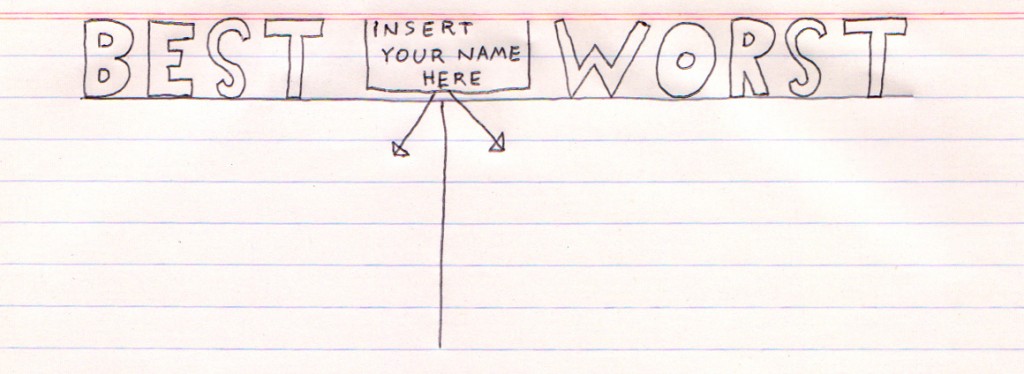Making the list: What we can learn from lists of the best and worst CEOs

We all aspire to be the “best”, but this means that there are those who are also the “worst”. Imagine that at some point in your career, after years of hard work and making your way to the coveted CEO position of a major company, someone walks up to you and says:
“Out of everyone in the entire world who performs a position like yours, across all countries and all industries, you are the absolute worst.“
This happens each year as the critically thinking public takes stock of the past twelve months. I question our propensity to be critical of those in positions that we have not experienced. I am unsure to what extent our propensity to judge is fueled by sensationalist headlines, or whether the media is a reflection of what we as a society need to consume.
Regardless, we can choose to set aside judgment and humbly take what is common in each list for practical application to avoid the mistakes and replicate the successes of others. This is what I encourage here.
The “best” lists
The Harvard Business Review 100 best performing CEOs in the world includes a top ten from Apple, Amazon.com, Samsung, Vale, Gilead Sciences, Hyundai, ITC, Simon Property Group, eBay, and Cisco Systems. The list is from a sample of 3,143 international CEOs from 1,862 international companies using company performance measurement five stock indexes adjusted for country and industry returns and changes in market capitalization.
The HBR research is unique in that it attempts to focus on long-term influence to determine success. Candidates had to have assumed their position after 1994 and before September 2010 and had to have been in their role longer than two years. The rankings are based solely on share price rather than a subjective assessment, but the tenure criteria ensure the results are sustainable for more than the current year.
The HBR list does not go into too much detail into what the individual CEOs did, but what they looked like:
- Internal versus external: 83% of the top 100 CEOs in the sample were hired from the inside. By comparison, 74% of all CEOs were hired from the inside. This varies by region, as some cultures are more prone to family-based structures that make it more difficult for an outsider to succeed.
- MBA: CEOs with an MBA rank on average 40 places higher than those without.
- Region: While CEOs from the US held six of the top ten slots, CEO’s in US companies ranked an average of 215 places lower than Latin American executives, 140 places lower than Indian CEOs, 137 places lower than British CEOs, and 108 places lower than Mexican CEOs. There was one Australian CEO, Grant Alfred King from Origin Energy at position 88.
- Social responsibility: There is no correlation between companies who achieve financial results and social responsibility, although 5% of CEOs achieved both. This is a topic for a whole other post.
The report from financial blog 24-7 Wall Street was perhaps less rigorous but added an element of subjectivity. The top eight include CEOs from Sprint, Discover Financial Services, Sherwin-Williams, Salesforce.com, Comcast Group, Starbucks, and LinkedIn. The sample size of “dozens” of companies larger than $3 billion were assessed on share price, execution, revenue, earnings per share growth for the most recent quarter and previous year, and evidence of substantial long-term plans for CEOs in their roles for at least two years.
Reasons given for the top spots include:
- Finding an investor (Sprint)
- Driving product innovation (ebay into auction and mobile)
- Diversification (LinkedIn multiple revenue streams of recruitment Talent Solutions (55% revenue), advertising Marketing Solutions (25% revenue), and Premium Subscriptions; Starbucks Refresher energy drinks, K-cup packs, Verismo System brewing machines; Discover’s evolution into lending)
- International expansion, reduced reliance on single market (Discover into China and Russia; Sherwin Williams replicating operations into Mexico)
- Luck (Sherwin Williams 30% market share in rising housing market)
- Success (Salesforce revenue growth over 34% and Forbes “most innovative company in the world”)
The “worst” lists
Sydney Finkelstein’s worst list has CEOs of Best Buy, Chesapeake Energy, Avon, Zynga, Bankia, with Facebook and Groupon as runners up. Forbes has a slightly different set with a focus on “worst screw ups” with CEOs of Chesapeake Energy, Best Buy, Avon, Zynga, Bankia, J. C. Penny, Susan G. Komen for the Cure, and the Long Island Power Authority. Herb Greenberg has a smaller list that includes CEOs of Groupon, Microsoft, J.C. Penny, Zynga, and Eastman Kodak.
Grouping the reasons why the companies are on these lists highlight areas to avoid:
- Integrity (Chesapeake Energy conflict of interests, use company employees and resources for personal work; Best Buy relationship with subordinate; Bankia sale of shares prior to bailout, under criminal fraud investigation)
- Lack of customer service and service innovation (Best Buy failed to improve customer service and online offerings, Long Island Power Authority poor response to Hurricane Sandy)
- Reliance on a single-source (Zynga reliance on Facebook)
- Failure to recruit, retain, or plan succession (Avon COO position vacant since 2006, failed to groom a successor; Zynga loss of top executives)
- Lack of governance and controls (Barclay’s participation in international rate fixing charges; HSBC money laundering charges; Groupon accounting restatements)
- Overly-optimistic guidance (J.C. Penny; Kodak overly-optimistic valuation of Kodak’s patents)
- Poor decisions (Best Buy $6.4B on share buy backs; Avon rejected $10.7B Coty acquisition; Zynga $200M acquisition of OMGPOP written down by 50% after seven months, CEO sold 16.5 million shares after IPO showing lack of faith; J.C. Penny removal of promotions and discounts, remodeling stores to more upscale, new advertising campaigns – all seen as ineffective; Susan G. Komen for the Cure funding flip flop for Planned Parenthood; Microsoft $6.3B write of of 2007 acquisition of aQuantive; Kodak entry into consumer printing business)
Learn from both
Finkelstein noted a main area that arose from his “worst” list was lack of governance. Organisations need leaders with integrity that give vision and direction applied with appropriate governance, realistic guidance, real engagement with the customer base beyond lip-service, and a product strategy suitable to the situation. These characteristics then guide the right decisions at the right time.
The applications of these principles are seen in the “best” lists. Some attributes from the best lists can help but are not guarantees. For example, while having an MBA was a factor in performance, the Zynga CEO has a coveted Harvard MBA and was known for their propensity for hiring MBAs but it did not stop them from being labeled as evil in infographics. Other aspects such as being hired internally or externally or the region one is in are more difficult to control.
As we set goals for the next year and keep the end in mind, we can consider to which list we will aspire. Success appears more situational, having the right strategy for the right situation at the right time by the right person. Failure on the other hand appears to be more general, having consistency in strategy and a standard of integrity and governance.
The purpose in such lists this is not to judge in criticism or envy those on either list. The extent that we judge others is often the extent to which we reflect on our own prior year with criticism or arrogance at our actions. The very nature of a list is relative positioning of one against another as well as the consumer of the list comparing themselves against those on the list. This is natural. It is what we do with the relative assessment that matters.
We can use the success and failures of others as a guide as we place our actions on our own list of best and worst in our field. It then becomes about progress rather than position. Perhaps making someone else’s list of “best” is not as important as reflecting on ourselves to be “better”, and in this way we may avoid ending up as “worst”.


1 thought on “Making the list: What we can learn from lists of the best and worst CEOs”
Comments are closed.